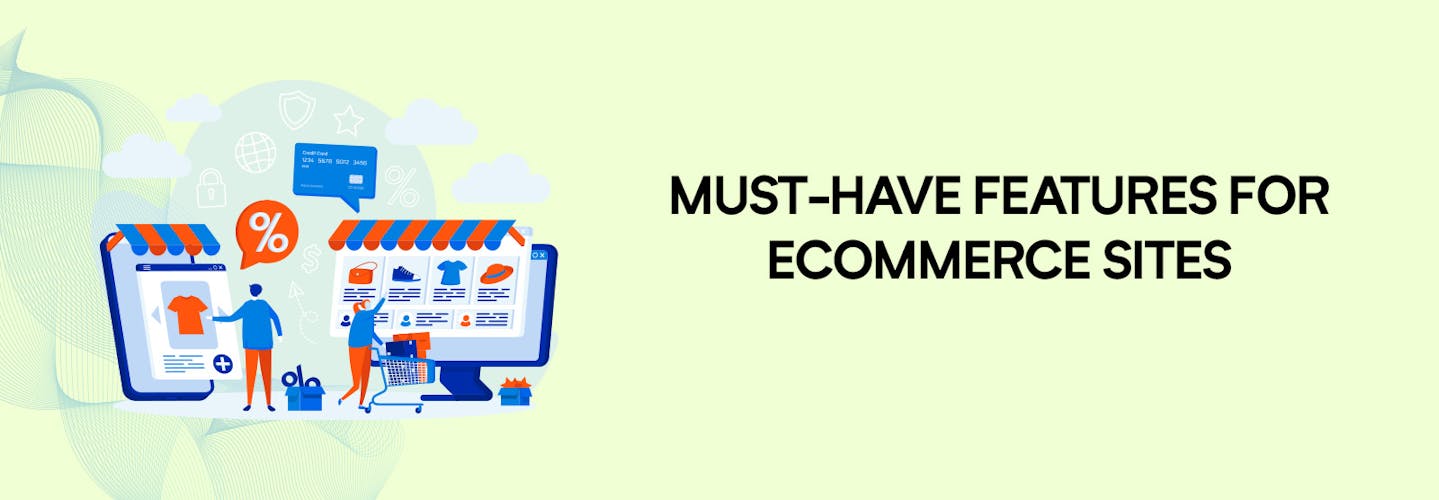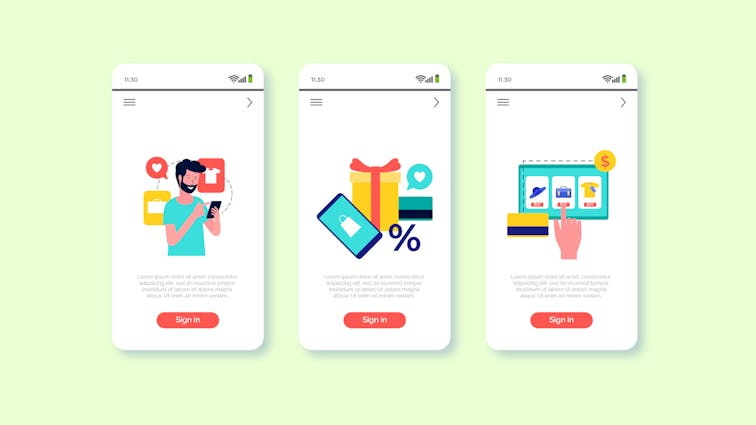
50 Must-Have Features for Your E-Commerce Website
Running a successful e-commerce website requires a comprehensive understanding of the essential features that can improve the shopping experience of your customers and increase your online sales.
In this list, we have compiled 50 must-have features that every e-commerce website should have to ensure smooth and secure transactions, intuitive navigation, and customer satisfaction.
From user-friendly design to personalized recommendations and social proof elements, these features can help your e-commerce business stand out and thrive in today’s competitive digital market.
Key Elements for an Effective E-commerce Website
Here’s a list of 50 must-have features to optimize your e-commerce website for maximum success.
User Interface and Store Setup:

1. Mobile Responsiveness
Ensure that your website is designed to appear correctly on mobile devices, as a majority of customers now interact with e-commerce platforms on their smartphones.
2. Clear Navigation Structure
Design your website with a clean and easy-to-understand navigation structure to help users quickly find the products and information they are looking for.
3. Search Functionality
Implement advanced search functionality that allows users to quickly find what they’re looking for by using filters like size, price, and color.
4. High-Quality Images and Videos
High-quality images and videos are crucial for showcasing products and attracting customers.
5. Product Descriptions
Your customers should understand everything they need to know about your product before purchasing, with clear and informative descriptions.
6. Customer Reviews and Ratings
Display customer reviews and ratings to help provide credibility and build trust among potential buyers.
7. Related & Frequently Bought Together Items
Showcase related products and frequently bought together items on individual product pages to encourage additional purchases.
8. Seamless Checkout Process
Design a seamless checkout process with minimal steps, clear shipping and payment options, and straightforward address input guiding customers smoothly through every stage of the purchasing journey.
9. Payment Gateways
Integrate various secure and trusted payment gateway options like PayPal, Stripe, and Amazon Pay, catering to customers’ preferred methods of online transactions and ensuring their financial safety.
10. Shipping Options & Tracking
Offer multiple shipping options (express, standard, free) to cater to different customer needs and provide tracking information for orders, updating customers on the progress of their deliveries.
11. Return & Refund Policy
Establish a concise return and refund policy that addresses common customer concerns and outlines the procedures, limitations, and timeframe for return and refund requests.
12. Live Chat Support & Customer Service
Incorporate live chat support on your e-commerce website or offer prompt customer service via email or phone to address any customer issues or questions in real-time, thus securing their loyalty and satisfaction.
Shopping Cart and Checkout:

13. Secure Shopping Cart:
Implement a secure encryption protocol (SSL, TLS) to protect customer data and encourage secure online buying.
14. Guest Checkout:
Enable guest checkout to allow customers to make a purchase without going through a complex registration process.
15. Clear Pricing and Shipping Information:
Make sure pricing and shipping options, as well as any applicable taxes, are easily accessible and straightforward.
16. Progress Indicator:
Implement a progress indicator on the checkout process so customers can understand how many steps they need to finalize their payment.
17. Flexible Payment Options:
Offer multiple payment methods, such as credit cards, PayPal, and additional country-based payment options (i.e., country-specific mobile wallets).
18. One-Page & Autofill Checkout:
Simplify your customers’ purchasing process by reducing forms and using autofill technology.
Customer Accounts and Assistance:

19. User-friendly Account Initialization & Recovery:
Ensure that account creation and password recovery is simple and user-friendly, enabling customers to manage them quickly.
20. Easily Accessible Customer Support:
Offer easy access to customer support through different channels (phone, email, chat) to resolve any purchasing issues.
21. Order History and Tracking:
Enable customers to view their order history, shipping information, track packages, and stay up to date on shipping status.
22. Wish Lists:
Allow customers to create wish lists or save for later” options to boost long-term product engagement.
Marketing and Conversion Features:

23. Newsletter and Promotions:
Utilize email marketing to keep customers updated on sales, promotions, and new products.
24. Social Media Integration:
Add social sharing/liking icons for these platforms within your product pages, blog posts, and other suitable areas on your website.
25. Abandoned Cart Recovery:
Track abandoned carts and create strategies to recover lost customers like sending reminder emails with slight (time-limited) discounts.
26. Upselling & Cross-selling Features:
Introduce upselling and cross-selling suggestions to encourage customers to purchase more products.
27. Loyalty Program:
Reward your customers by implementing a loyalty program that grants special discounts, rewards points, or exclusive promotions.
SEO & Analytics:

28. SEO-Friendly URLs and Metadata:
Optimize e-commerce website structure and code for search engine visibility, with legible URLs, meta tags, headlines, and alt texts.
29. Sales Reports & Analytics:
Integrate sales and analytic tools (e.g., Google Analytics) to monitor important statistics, helping you understand and evaluate customer behavior and preferences.
30. Heatmap Tracking:
Implement heatmap services like Hotjar or Lucky Orange to track how users interact with the website and optimize utilization of this information.
31. On-Page Optimization:
Make sure every page includes target keywords, an engaging title, relevant content, and rich media (images, videos) for better presence on search engines.
32. Site Speed Optimization:
Optimize page performance and site loading times to improve user experience and ranking on search engines like Google.
33. XML Sitemap & Robots.txt:
Include a well-structured XML sitemap and implement robots.txt files to ensure search engines correctly crawl and index your website’s crucial pages.
34. Structured Data Implementation:
Use structured data (schema markup) to allow search engines to quickly address specific elements of your site, like product pricing, images, and user reviews, improving visibility on SERPs.
35. SSL Certificate Implementation:
Ensure you have a valid SSL certificate for your site to enhance security and build trust in both search engines and customers.
36. Localized SEO for Multiple Regions:
Optimize your multi-language or multi-region e-commerce websites to fulfill the needs in specific countries or regions.
37. Social Signals & Sharing:
Encourage user-generated content through social media shares, like or follow incentives, which increase website visibility in search results.
38. Content Marketing & Guest Blogging:
Create valuable and relevant blog posts, articles or guides to drive organic, loyal customer base, and leverage guest blogging to widen your audience reach and improve your online authority.
Mobile Compatibility:

39. Responsive Design:
Ensure your e-commerce website has a responsive design that adapts to various display sizes for seamless navigation across different devices, like smartphones and tablets.
40. Swift Mobile Performance:
Optimize your e-commerce site for efficient mobile loading times and responsiveness, reducing bounce rates and enhancing dwell time.
41. Mobile-friendly Layout:
Design a user-friendly mobile layout with legible text, easily accessible menu, and navigation options providing a great user experience on smartphones and other mobile devices.
42. Touchscreen Compatibility:
Ensure that your e-commerce website is fully compatible with touchscreens for smooth navigation and interaction using scrolling, swiping, and tapping gestures on mobile devices.
43. Mobile Payment Options:
Include mobile payment options like Apple Pay, Google Pay, or other mobile wallets to offer customers a convenient and secure way to pay from their smartphones.
Additional Key Elements for Effective E-commerce Functionality:
44. Multi-language support:
Multi-language support allows your e-commerce website to be accessible to a wider range of customers who speak different languages by providing them with language options.
45. Multi-currency support:
Multi-currency support allows customers to view product prices and make payments in their preferred currency, which can improve their shopping experience and increase your sales.
46. Social proof elements (trust badges, customer reviews, etc.):
Social proof elements such as trust badges and customer reviews can help build trust and credibility with potential customers by showing them that your e-commerce website is reputable and reliable. They can also influence purchase decisions and increase conversion rates by providing social validation for your products or services.
47. Product alerts (price drops, back in stock, etc.):
Product alerts allow customers to receive notifications when products they are interested in are back in stock or when their prices drop, which can increase their chances of making a purchase. This functionality can also help you to re-engage with potential customers and encourage them to come back to your website.
48. Tax calculation functionality:
Tax calculation functionality automatically calculates and adds the appropriate taxes to the customer’s order based on the location of the customer and the tax laws that apply to your business, making it easier for both the customer and the business to manage tax-related issues.
49. User-generated content section:
A user-generated content section allows customers to share their own experiences and opinions about products or services, which can help build a community around your brand and increase engagement with your e-commerce website.
50. Integrations with CRM & Marketing Automation platforms:
Integrate your e-commerce website with CRM (Customer Relationship Management) and marketing automation platforms to streamline your business processes, manage customer data, and optimize marketing campaigns, ultimately increasing customer engagement and boosting sales.
Conclusion:
Having these 50 features in place not only helps create a smooth and enjoyable shopping experience, but will also directly affect your website’s conversion rate and strengthen customer loyalty.
Invest in optimizing your e-commerce website and keep an eye on emerging trends to stay ahead of the competition.








